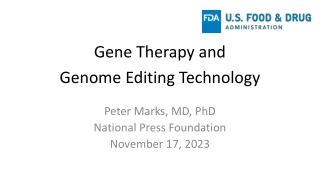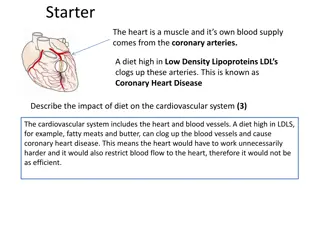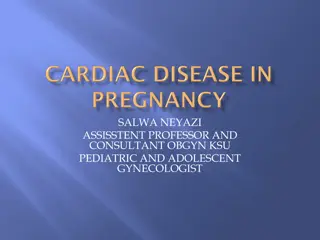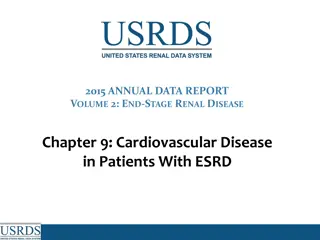Shared Mechanisms of CLRD and Cardiovascular Diseases: Candidate Gene Associations
Chronic Lower Respiratory Disease (CLRD) and cardiovascular diseases are closely linked, with shared genetic traits identified through candidate gene associations. Studies have shown an increased risk of cardiovascular disease in patients with CLRD, highlighting the importance of understanding the genetic underpinnings of these conditions. Through the analysis of candidate genes across various cohorts, a deeper insight into the relationship between CLRD and cardiovascular diseases can be gained.
Download Presentation

Please find below an Image/Link to download the presentation.
The content on the website is provided AS IS for your information and personal use only. It may not be sold, licensed, or shared on other websites without obtaining consent from the author.If you encounter any issues during the download, it is possible that the publisher has removed the file from their server.
You are allowed to download the files provided on this website for personal or commercial use, subject to the condition that they are used lawfully. All files are the property of their respective owners.
The content on the website is provided AS IS for your information and personal use only. It may not be sold, licensed, or shared on other websites without obtaining consent from the author.
E N D
Presentation Transcript
Physical Fitness and Recreational/Home Safety
Learning Topics Importance of physical fitness Importance of recreational home safety Physical fitness test Male & female standards Definitions Stretching 10 basic stretches Chemical warning labels Some dangerous home material Recreational safety Definition of PPE Conclusion
Importance Able to maintain physical readiness Working out safely Being safe recreationally Being safe at home
Physical Readiness Test Navy Curl-Ups Push-ups 1.5 mile run/walk Marines Pull-ups Curl-ups 3 mile run/walk
17-19 Male PRT Standards Performance Points Curl-ups Push-ups 1.5 mile run Levels Maximum 100 109 92 8:15 Outstanding 90 102 86 9:00 Excellent 75 90 76 9:45 Good 60 62 51 11:00 Satisfactory 45 50 42 12:30 Failure FAIL <50 <42 >12:30
Males: Age 20-24 Performance Points Curl-ups Push-ups 1.5 mile run Levels Maximum 100 105 87 8:30 Outstanding 90 98 81 9:15 Excellent 75 87 71 10:30 Good 60 58 47 12:00 Satisfactory 45 46 37 13:30 Failure FAIL <46 <37 >13:30
17-19 Female PRT Standards Performance Points Curl-ups Push-ups 1.5 mile run Levels Maximum 100 109 51 9:29 Outstanding 90 102 47 11:30 Excellent 75 90 42 12:30 Good 60 62 24 13:30 Satisfactory 45 50 19 15:00 Failure FAIL <50 <19 >15:00
Females: Age 20-24 Performance Points Curl-ups Push-ups 1.5 mile run Levels Maximum 100 105 48 9:47 Outstanding 90 98 44 11:30 Excellent 75 87 39 13:15 Good 60 58 21 14:15 Satisfactory 45 46 16 15:30 Failure FAIL <46 <16 >15:30
Marines (Female) Points Flexed-Arm Hang 100 70 sec 99 98 69 sec 97 96 68 sec 95 94 67 sec 93 92 66 sec 91 90 65 sec 89 88 64 sec 87 86 63 sec 85 84 62 sec 83 82 61 sec 81 80 60 sec Crunches 3-Mile Run 21:00:00 21:10:00 21:20:00 21:30:00 100 99 98 97 96 95 94 93 92 91 90 89 88 87 86 85 84 83 82 81 80 21:40 21:50 22:00 22:10 22:20 22:30 22:40 22:50 23:00 23:10 23:20 23:30 23:40 23:50 24:00:00 24:10:00 24:20:00
A Few Definitions Aerobic activity- exercises including walking, riding a bike, or swimming. This helps your heart, lungs, and muscle tone. Muscle strength- exercises include types of resistance training. This helps build strong bones and muscles. Stretching- helps with flexibility and balance. Do all stretches gradually. Don't push or bounce the stretch. You should feel a stretch, not pain.
Stretching Warm up first Hold each stretch for at least 30 seconds Don't bounce Focus on a pain-free stretch Relax and breathe freely Stretch both sides Stretch before and after activity
10 Basic Stretches Calf Stretch Hamstring Stretch Quadriceps Stretch Hip Flexor Stretch Iliotibial Band Stretch (ITB) Knee-to-Chest Stretch Shoulder Stretch Shoulder Stretch with Towel Neck Stretch Upper Back Stretch
Home Safety Be aware of common warning labels Be aware of dangerous home materials Know intended use of chemicals
Chemical Warning Labels DANGER means that the chemical is harmful or fatal if swallowed WARNING means that the chemical is harmful if swallowed CAUTION means that the chemical is harmful if swallowed
Some Dangerous Home Material 12 Most Dangerous Household Chemicals 1. Air Fresheners 2. Ammonia 3. Bleach 4. Carpet and Upholstery Shampoos 5. Dishwasher Detergents 6. Drain Cleaners 7. Furniture Polish 8. Mold and Mildew Cleaners 9. Oven Cleaner 10. Antibacterial Cleaners 11. Laundry Room Products 12. Toilet Bowl Cleaners Use Chemicals for their intended use!
Recreational Safety Be Aware of all safety issues for any recreational activity Know and use all proper personal protective equipment (PPE) Do all to prevent injury/death for all parties involved
Definition of PPE Personal Protective Equipment (PPE) - Specialized clothing or equipment worn by employees for protection against health and safety hazards. Personal protective equipment is designed to protect many parts of the body, i.e. eyes, head, face, hands, feet, and ears.
Conclusion Be aware of Official Navy PRT standards and strive for improvement Practice safety in all physical activities Know your household chemicals and make sure they are secure Wear all proper PPE for all recreational activities you choose to participate in
References Banner Health, Recreation Safety Tips- http://www.bannerhealth.com/Services/Health+And+Wellness/Safety/Recreation+Safety.htm 12 Most dangerous household chemicals http://www.achooallergy.com/blog/dangerous-household-chemicals/ MayoClinic, A guide to 10 basic stretches http://www.mayoclinic.com/health/stretching/SM00043 Navy Personnel Command http://www.public.navy.mil/BUPERS-NPC/SUPPORT/PHYSICAL/Pages/Guides.aspx Department of Defence Instruction www.dtic.mil/whs/directives/corres/pdf/130803p.pdf Navy PRT Standards OPNAVINST 6110.1J Marine Corps Order 6100.13 W/CH 1 http://www.marines.mil/news/publications/Documents/MCO%206100.13%20W_CH%201.pdf























